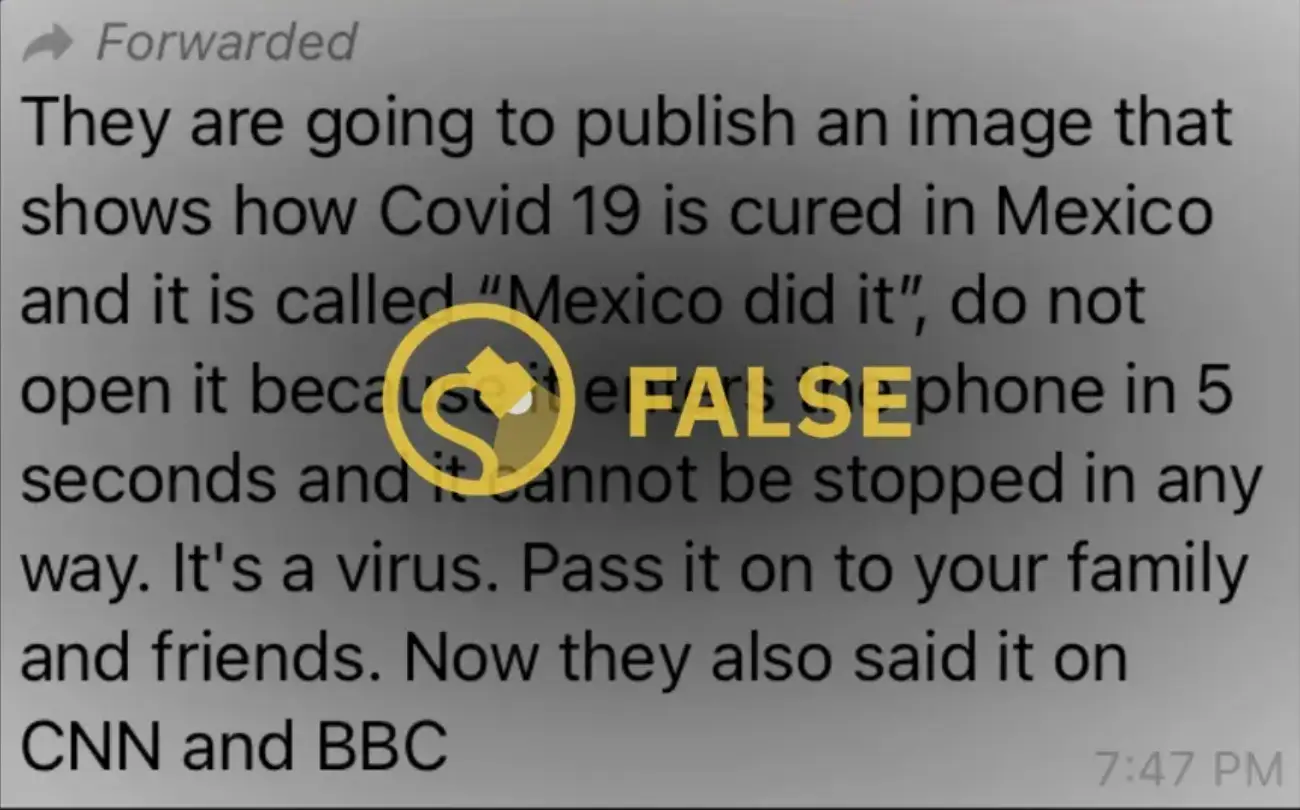Mexico Did It Scam – In this article, we delve into the viral hoax surrounding the Mexico Did It photo and virus, which has been circulating on social media platforms. Our aim is to provide an objective and fact-based analysis of this claim, debunking its falsity.
Additionally, we explore the concept of image-based malware and emphasize the importance of practicing good internet hygiene to reduce the risk of infection.
Join us as we separate fact from fiction and encourage responsible internet practices.
Table of Contents
Mexico Did It Scam – The Origin of the Hoax
The origin of the hoax surrounding Mexico Did It photo or virus can be traced back to a modified version of a previous fake message called ‘Argentina is doing it.’
Understanding the motivations, psychology, and tactics behind creating viral hoaxes is crucial in analyzing the impact they have on public perception and behavior.
Viral hoaxes often play on people’s fears and desires for safety and protection. They exploit our natural tendency to share information that seems urgent or alarming, seeking validation and a sense of belonging within our social networks.
The Mexico Did It hoax, like many others, spreads rapidly through platforms like WhatsApp and social media, causing unnecessary panic and anxiety.
Understanding Image-Based Malware
Digital steganography enables the concealment of secret messages and data within digital files like photos or videos. While this technique has legitimate uses for privacy and security, it also poses risks in the form of image-based malware.
Malicious actors can embed malicious code within an image, although it may not be a full-fledged malware. However, it is important to note that image-based malware requires user action, such as downloading or installing from unknown websites.
Contrary to the claims made in the viral hoax about the Mexico Did It photo, the execution of malicious code happens immediately and not after a few seconds.
Practicing good internet hygiene, such as avoiding downloads or installations from unknown sources, significantly reduces the risk of infection.
It is crucial to stay vigilant and informed to protect oneself from potential threats.
Debunking the 5-Second Infection Claim
Contrary to the claim, the execution of malicious code in image-based malware occurs immediately upon triggering, rather than after a few seconds as suggested.
This misinformation about a Mexico Did It photo/virus highlights the role of social media in spreading viral hoaxes.
Psychological factors such as fear and urgency contribute to the spread of such misinformation. People are more likely to share alarming messages without verifying their accuracy, driven by a desire to protect their loved ones and be part of a community that shares information.
Unfortunately, this can result in the rapid dissemination of false information, causing unnecessary panic and confusion.
To combat the spread of viral hoaxes, it is crucial for individuals to critically evaluate information before sharing it, relying on trusted sources and fact-checking organizations.
The Importance of Internet Hygiene
Practicing good internet hygiene by being cautious of unknown sources and avoiding suspicious downloads or installations is essential in protecting oneself from potential online threats. Failing to do so can have serious consequences, including:
Increased risk of malware infection: Opening unknown files or downloading from untrustworthy websites can expose your device to malware. Malicious code embedded within files can execute immediately, compromising the security of your device.
Data breaches and identity theft: Visiting insecure websites or sharing personal information online without proper precautions can make you vulnerable to hackers. This can lead to unauthorized access to your sensitive data, such as financial information or personal details, which can be used for identity theft.
Loss of privacy and personal information: Engaging in unsafe online practices can result in the exposure of your private information to cybercriminals. This can include your browsing history, passwords, social media accounts, or even your location, putting your privacy at risk.
To stay safe online, consider the following tips:
- Keep your devices and software updated to ensure you have the latest security patches.
- Use strong, unique passwords for each of your online accounts.
- Enable two-factor authentication for an extra layer of security.
Support for the Author
Support for the author, Dr. Adrian Wong, can be provided through bank transfer, PayPal, or credit card.
Dr. Adrian Wong has been writing about tech and science since 1997 and continues to devote countless hours to his work. His contributions to the field have been invaluable, providing readers with accurate and insightful information.
To show appreciation for his dedication, readers have the option to support him financially. Payment options such as bank transfer, PayPal, or credit card make it convenient for supporters to contribute.
The Truth About the Mexico Did It Virus
Digital steganography allows for the concealment of hidden messages and data within digital files like images. However, it is important to note that these hidden codes do not pose a significant threat as full-fledged malware.
The recent viral hoax about the Mexico Did It photo/virus highlights the psychology behind viral hoaxes and the role of misinformation in spreading fear and panic. Here are three key points to consider:
Psychological factors: Viral hoaxes tap into our innate curiosity and desire for belonging. They exploit our fears and create a sense of urgency to share the information with others.
Misinformation amplification: Social media platforms provide an ideal breeding ground for the rapid spread of hoaxes. People often share information without verifying its authenticity, leading to the widespread dissemination of false claims.
Fear and panic: Viral hoaxes can create panic and anxiety among individuals who believe in their validity. This can lead to unnecessary stress, wasted time, and even damage to personal relationships.
It is crucial to approach information critically, verify its authenticity, and rely on reputable sources before sharing or spreading any claims.
Practicing Vigilance Against Viral Hoaxes
Maintaining a critical mindset and verifying information from reputable sources can help individuals protect themselves against the spread of false claims. Recognizing and reporting fake news is crucial in today’s digital age, where viral hoaxes can have a significant impact on social media.
The Mexico Did It photo/virus claim is a prime example of how misinformation can quickly spread and cause panic. By being vigilant and fact-checking before sharing information, individuals can help curb the spread of viral hoaxes.
It is important to rely on trusted sources and not rely solely on social media for news. By doing so, individuals can contribute to a more informed and responsible online community, where false claims are identified and debunked.
Conclusion
In conclusion, the viral hoax surrounding the alleged Mexico Did It photo and virus has been thoroughly debunked. The claim of a virus infecting users’ phones within 5 seconds is entirely false and lacks any factual basis.
While image-based malware is technically possible, it requires deliberate user action for execution. Practicing good internet hygiene, such as avoiding downloads from unfamiliar websites, is crucial for reducing the risk of infection.
It is important to remain vigilant against viral hoaxes and rely on factual information.
Also Read
Mason Blake Recruitment Whatsapp Scam – Don’t Fall Victim
Elite Healthcare & Wellness Scam or Legit? Don’t Be Fooled
Pinreadca Com Scam or Legit? Don’t Fall Victim
Also Read
Floresta Reviews – Is Floresta Legit or a Scam? Don’t Fall It
Ccdrrf Com Scam or Legit? – Ccdrrf.Com Exposed
Roalert.com Reviews – Is Roalert.com Legit or a Scam?
Also Read
Meaifeer Reviews – Is Meaifeer Legit or a Scam?
Libiyi Drill Bit Reviews – Is Libiyi Drill Bit Legit or a Scam?
Smartwool Sale Scam or Legit? Smartwool.Sale Exposed
Also Read
Thor Shipping Scam Exposed – Unveiling the Thor Shipping
Antal International Scam Exposed – Don’t Be Fooled
Moroccan Earthquake Whatsapp Scam Exposed – Don’t Be Fooled!
Also Read
Seismic Waves Card: Unmasking the Seismic Waves Card Scam
Startrack Club Scam Exposed: Don’t Be The Next Victim!
HDB Parking Scam Exposed: Don’t Fall Victim!
Also Read
Sawtowel Reviews – Is Sawtowel Legit or a Scam?
Mlbcap.com Reviews: Is Mlbcap.com a Scam or Legit?
John Blue Scam Email – Unveil the Secrets of John Blue Scam
Also Read
Amplirefund Scam – Don’t Be Their Next Victim!
Vibe Refunds Scam – Don’t Fall for This Fake Tax Refund Text
Pulse Refund Text Scam – Fake Refund Text Scam
Also Read
Versor Engineering Scam – Unmasking the Versor Engineering
Lolly Hair Reviews: Is Lolly Hair Legit or a Scam?
Discount Ammo Store Scam or Legit? Don’t Get Scammed
Also Read
Dotveil Com Scam or Legit? Don’t Be The Next Victim!
Zappos Power Scam – Discover the Hidden Truth Behind This
Glasana Scam or Legit? Uncover the Secrets of This Jewellery Store
















































